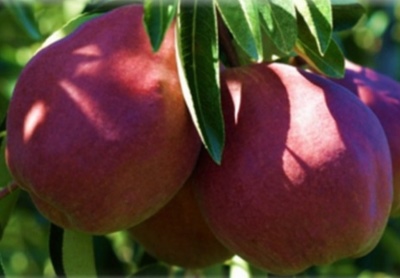
- Authors: Fratia
- Appeared when crossing: mutant (clone) of the Williams variety
- Name synonyms: Max red Bartlett
- Year of approval: 1974
- Fruit weight, g: 180
- Ripening terms: late summer
- Fruit picking time: In the end of August
- Appointment: universal
- Growth type: low growth
- Yield: medium
Along with the numerous pear species that have been bred, gardeners are often confronted with varieties resulting from natural mutations. A striking representative of this process is the late summer pear with the unusual name Williams Rouge Delbara.
Breeding history
Pear Williams Rouge Delbara is not the result of the works of scientists, but a clone of the famous Williams variety of French selection, obtained by ordinary natural mutation. Permitted for use pear species in 1974. The fruit crop is zoned in the North Caucasian region. The pear has another name - Max Red Bartlett.
Description of the variety
The pear is a weakly growing tree, characterized by a round-pyramidal crown shape and compactness. The crown has medium thickening with dark green leaves with a glossy surface, moderate branching (branches grow at an acute angle) and fissured bark. The flowering of the tree is relatively late, but the flowers are resistant to low temperatures. During the flowering period, the trees are densely covered with large snow-white flowers, pleasantly fragrant.
Fruit characteristics
The pear belongs to the above-average fruit class. With proper agricultural technology and in favorable climatic conditions, the fruits gain weight up to 180 grams, sometimes a little more. The shape of the fruit is correct - pear-shaped or oblong-pear-shaped with a noticeable tuberosity of the surface. Ripe pears are very attractive - a bright yellow base with a pronounced dark red blush. The skin of the fruit is thin, shiny, with pronounced yellowish-pink subcutaneous punctures.
The purpose of the fruits is universal - they are eaten fresh, used in cooking, processed into jam, marmalade, mashed potatoes, juices. The transportability of the variety is average, but the shelf life is long (until the end of autumn), the main thing is to observe the correct conditions. Pears are stored frozen for 12-18 months.
Taste qualities
Pears are not only attractive in appearance, they have an amazing taste. The yellowish-white flesh is endowed with a tender, fleshy, fine-grained and melting structure, complemented by juiciness. The fruit has a balanced taste - bright sweetness with nutmeg aftertaste. Sometimes, under the influence of climatic conditions, the fruit acquires a pleasant sourness. The pulp contains up to 9% sugars.
Ripening and fruiting
Pear belongs to the category of late summer varieties. The tree begins to bear fruit in the 4-5th year after planting. Harvesting maturity occurs at the end of August. Pears become absolutely ripe 15-20 days after being removed from the branch.

Yield
The fruit crop yield is average. With timely watering and top dressing, about 10-12 tons of ripe fruits can be removed from 1 hectare of pear orchard.
Growing regions
Pears are massively grown in the North Caucasus (North Ossetia, Chechnya, Ingushetia, Krasnodar Territory, Kabardino-Balkaria, Adygea).Recently, this variety has gained popularity in the Rostov region, as well as in Ukraine, Belarus, Moldova, Kyrgyzstan.
Self-fertility and the need for pollinators
This pear species is self-fertile, so donor trees are indispensable. As pollinators, it is recommended to plant species whose flowering period coincides with the Williams Rouge Delbara pear. Suitable donors are: Bere Giffard, Favorite Clappa, Forest Beauty, Olivier de Serre and Bere Gardi.
Landing
For planting, it is better to buy one / two-year-old seedlings with a developed root system, formed by a central shoot and 4-5 branches. The seedling should not have any mechanical damage. They can be planted in autumn and spring, depending on the climatic conditions of the regions.


Growing and caring
It is recommended to grow a pear on fertile, breathable and well-drained soils. The area must be exposed to sun and light. To prevent decay of the root system, it is necessary that the groundwater passes as deep as possible.
Agricultural technology of fruit crops is watering, feeding, loosening and mulching of the near-stem zone, sanitary pruning of branches, crown formation, as well as protection from diseases and insects. For the winter period, procedures are carried out to warm the root system and the tree.



Disease and pest resistance
The immune system of a pear is able to resist some fungal diseases. The cultivar has an average resistance to scab, but is susceptible to cytosporosis, fruit rot and root cancer. To prevent many diseases, prophylactic treatments with fungicides will be required. As for insects, most often the tree is attacked by aphids, copperheads, pear mites and Californian scale insects.

Like any other fruit trees, the pear needs protection from various diseases and pests. When planting a pear on your site, you need to know in advance what diseases you should beware of.To successfully carry out the struggle, it is necessary first to correctly identify the cause of the problem. It is important to distinguish signs of disease from manifestations of the presence of insects, mites, caterpillars and other types of pests.
Resistance to soil and climatic conditions
The tree's resistance to stress is moderate, so it does not tolerate frost well, as well as prolonged drought. In addition, the pear does not perceive drafts and prolonged shading.





































































